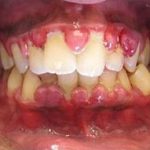Refers to gingival inflammation induced by bacterial biofilms (also called plaque) adherent to tooth surfaces.
Inflammation of the gums as a result of bacterial infection.
In dentistry, an inflammation of the gingivae due to infection, impaction of food, and faulty fillings.
Mild inflammation of the gums (gingiva), in which the gums become reddish, swollen, tender, and prone to bleed, especially during brushing. Gingivitis normally results from infection due to plaque that has collected on teeth because of inadequate cleaning. Local irritation from too much brushing or flossing or from malocclusion can also lead to gingivitis, as can some nutritional diseases, such as scurvy, and some types of medications that cut saliva flow, such as antihistamines. Because of hormonal changes in the body, pregnant women and women taking birth-control pills are susceptible to gingivitis. So are people with diabetes, including perhaps 20 percent of teenagers who developed insulin-dependent diabetes mellitus (IDDM) as children. Treatment of gingivitis involves regular, careful cleaning of the teeth by the dentist at least once a year. If gingivitis is untreated, the gums loosen their hold on the teeth and form pockets where plaque collects. Eventually, infection attacks both the bone and tissues surrounding the teeth, resulting in an advanced stage of gingivitis called periodontitis, in which teeth are loosened and may be lost. Dentists or specialist periodontists may still be able to save some teeth by cutting away diseased gum tissue, a procedure called gingivectomy, to see if healthy gum tissue will grow back around the tooth. If that fails, periodontists may attempt to rebuild the tooth support through a combination of bonelike laboratory materials and grafts of healthy gum tissue from elsewhere. Though often associated with adults, gingivitis also affects adolescents and causes serious damage and premature loss of teeth.
Condition in which the gums are red, swollen, and bleeding. It most commonly results from poor oral hygiene and the development of bacterial plaque on the teeth, but is also common in pregnancy and may be a sign of another disorder (e.g., diabetes mellitus, vitamin deficiency).
Inflammation of the gums, which become swollen and bleed easily. Chronic gingivitis is an early stage of periodontal disease.
A condition in which the gums become red and infected and begin to pull away from the teeth.
A condition in which the gums become red and swollen and bleed easily.
Inflammation of the gums, seen as painless bleeding during brushing and flossing.
Gingivitis is the inflammation of the gums, often caused by the accumulation of plaque around the lower part of the teeth. Bacteria in the plaque produce toxins that irritate the gums, leading to infection, swelling, tenderness, and a reddish-purple color. In addition to plaque, gum injury from aggressive toothbrushing or flossing can also contribute to gingivitis. Pregnant women and individuals with diabetes mellitus are particularly vulnerable to this condition.
Gingivitis is a reversible condition, and the primary way to prevent and treat it is through good oral hygiene. However, if left untreated, it can cause harm to the gum tissue, potentially progressing to chronic periodontitis, an advanced form of gum disease. In some cases, people with chronic gingivitis, especially those with weakened immunity to infections, may develop acute ulcerative gingivitis. It’s essential to maintain proper oral care to avoid such complications.

